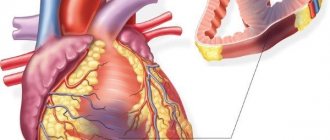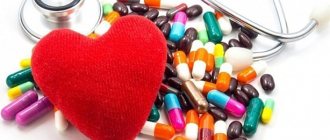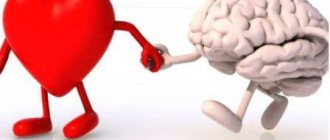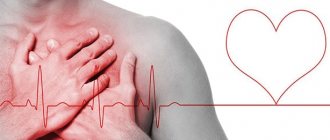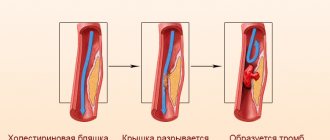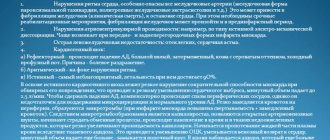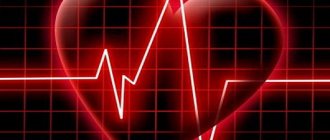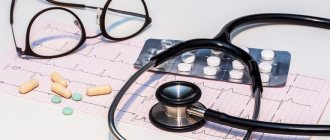Myocardial infarction is known to most patients as a terrible, life-threatening diagnosis. Almost all patients with cardiovascular and related pathologies fear its development. Among them are patients with hypertension, angina pectoris, atherosclerosis, and diabetes mellitus. But this is a huge, overwhelming group of the population, usually over the age of 40. Thus, a heart attack poses a direct threat to life for each such patient. In order to prevent the development of a vascular accident in time, each patient needs to have the most important information about a heart attack. Perhaps this information will help save your health and life.
In this article we will discuss:
- Diagnosis of a heart attack - what does it mean?
- Why are patients so afraid of heart attacks?
- How to notice the onset of a heart attack in time?
- How to distinguish pain during a heart attack from angina?
- When to call an ambulance?
- What to do before the ambulance arrives to survive?
- How to prevent a heart attack in time?
- How to avoid a repeat vascular accident?
What is a heart attack?
Myocardial infarction is the death of a section of the heart muscle as a result of a sudden lack of oxygen supply from the blood.
At the same time, the prerequisites for the development of a heart attack can develop in a patient over years and even decades. However, the heart attack itself occurs suddenly and is very fleeting.
It's been like this for 15 minutes
completely blocking the blood flow to an area of the heart muscle is enough for
irreversible
cell death to occur.
It is important to understand that the longer measures are not taken, the more serious and extensive the area of the heart attack will be
.
This means that its consequences are more dangerous for life. That is why it is extremely important from the very first minutes of an attack to suspect the probable development of a heart attack and urgently begin to take measures
to save health and life.
Why is there blood suddenly
stops flowing to the heart area? There are only two main reasons:
- Blood clot formation
(blood clot) completely blocking the vessel supplying the heart (coronary artery). Often such blood clots form where the heart vessel is already narrowed. A thrombus can sit on a cholesterol plaque, can break away from it and wander through the vessel, and can form in places where the vessel is naturally narrowed. In all these cases, blockage of the vessel may occur, sudden blockage of cardiac blood flow and a heart attack may develop. - Spasm of the vessel supplying the heart
is a rather rare but possible cause of a heart attack.
Food and alcohol
Heart attack prevention also includes proper nutrition. If the patient is obese, all efforts should be aimed at losing weight, since obese people have a higher load on the heart.
In such patients, the level of “bad” cholesterol is always higher. But atherosclerosis also threatens thin people if they consume too much fatty meats, cheeses, and dairy products. It is recommended to monitor the amount of “bad” cholesterol in the diet from at least 35-40 years of age.
It is necessary to avoid products such as:
- fatty meats (lamb, pork, duck);
- sausages, sausages, various smoked meats;
- ready-made semi-finished products (cutlets and dumplings) - they contain hidden fats, which increase cholesterol and cause atherosclerosis;
- pates and liver dishes;
- fat cottage cheese and cream.
Preventing cardiovascular diseases is much easier for those people who include a lot of vegetables and fruits in their diet. For example, pomegranate fruits contain polyphenols that lower blood pressure. Garlic contains sulfides that prevent the formation of blood clots. Legumes contain saponins that fight inflammatory processes. And almost all plants contain phytosterols - hormone-like substances that lower cholesterol levels.
To protect yourself from a heart attack, it is recommended to include in your diet not only vegetables and fruits, but also foods such as:
- dietary meats (chicken, turkey, rabbit); When cooking poultry, be sure to remove the skin and fat;
- whole grain porridge;
- fatty fish, which is rich in omega-3 polyunsaturated fatty acids, which increase the elasticity of the walls of blood vessels.
Important information: Symptoms and treatments for kidney infarction
It is necessary to regulate not only the amount of fat, but also the amount of sugar in the daily diet, since there is a direct connection between this indicator and myocardial infarction.
Why is a heart attack dangerous, and why are patients so afraid of it?
It is widely known that if help is not provided in time, you can die from a heart attack. This is true. Myocardial infarction occupies one of the leading places in the mortality statistics of the population of our planet. Between 25% and 35% of all heart attacks that occur are fatal. But what about the remaining 75%?
Having a heart attack can lead to loss of ability to work
and even lead to
disability
of the patient.
Why is this happening? The thing is that the area of the heart muscle lost as a result of a heart attack is switched off from the work of the heart and ceases to perform its functions. This is how the failure of the heart develops - heart failure
of one degree or another.
The second possible consequence of a heart attack is no less dangerous - disturbances in the rhythm of the heart (arrhythmias)
.
Arrhythmias always
require monitoring and treatment, as they are potentially life-threatening conditions and can themselves lead to cardiac arrest. As a result of all this, a person, in fact, loses the ability to fully endure stress - both physical and mental. Of course, the loss of heart function directly depends on the extent of the infarction.
How dangerous is a microinfarction?
A microinfarction, as a rule, does not lead to significant disability.
The affected area of the heart muscle is small. The danger of such a condition and its prospects are easy to underestimate
.
Thus, it is precisely patients who have suffered a microinfarction who are most susceptible to repeated heart attacks
in the future. This means that correct diagnosis of the causes of the incident and further prevention are also extremely important for them.
Lifestyle
To avoid a heart attack, both primary and secondary prevention are important. In the first case, we are talking about medical examination of patients, as well as those who belong to the risk group, i.e. suffering from arterial hypertension, diabetes mellitus, obesity, chronic neuropsychic overload. As for secondary prevention, it is mandatory for those people who have already suffered a myocardial infarction, so now it is important for them to exclude relapses.
Primary prevention is the treatment of coronary heart disease and the elimination of risk factors. The secondary goal is to prevent a reoccurrence of the situation, and action must be taken literally immediately after the patient’s acute phase of the pathology ends.
An important role in prevention is played by the elimination of risk factors, which requires significant changes in the patient’s life. To change your lifestyle, you need to understand what adjustments need to be made to it.
The risk group includes men over 45 years of age and women over 50 years of age. Moreover, in the post-Soviet space, about 30% of cases of myocardial infarction end in death, while in Europe only 5-10%, and even this is considered a fairly high figure.
The risk of heart attack increases:
- regular smoking, both active and passive;
- alcohol;
- chronic lack of sleep;
- overeating and excess weight.
At the same time, lifestyle changes help reduce the risk of pathology:
- playing sports at least three times a week;
- proper nutrition, in which the diet includes at least 5 vegetables or fruits daily;
- elimination of emotional shocks and risk factors for the nervous system;
- a full night's sleep;
- preventive examinations at least once a year (the basic package should include an ECG, a blood test, and after 40 years - a stress test with physical activity);
- taking vitamins.
Important information: Classification of types and stages of myocardial infarction
When a person is at risk of a heart attack, prevention can come down to walking for 30-40 minutes every day. If at first, in the absence of proper dexterity, the patient walks slowly, then after a month he will be able to increase the speed to 80 steps per minute, and over time he will switch to race walking - 120 steps per minute. And without shortness of breath and weakness - these symptoms will go away as you train.
Physical activities such as cycling, climbing stairs, and swimming are good for preventing heart attacks. Some experts believe that dancing is also an acceptable form. However, dance training should not be too intense - 2-3 times a week for 40 minutes.
Are there any warning signs of a heart attack?
Is it possible to predict in advance
onset of a heart attack?
There is such an opportunity, but such a chance is presented quite rarely
. So, in some cases, already a few weeks or days before a heart attack, pain may appear behind the sternum, sometimes radiating to the left half of the body. If you already have a large number of concomitant diseases, or are elderly without previous pain in the heart area, this is practically the only chance to be alert, examined and prevent the onset of a vascular catastrophe.
Unfortunately, in the vast majority of cases such precursors are absent. And the heart attack itself occurs suddenly, based on the underlying pathology that the patient has been suffering from for years. Thus, the list of factors that can significantly increase the likelihood of developing a heart attack includes:
- Elderly age
- Previous heart attack
- Smoking
- Diabetes
- Arterial hypertension
- High cholesterol
- Overweight
Features of the course of the disease in women
The development of a heart attack in young women is quite rare. This manifestation mainly worries patients before and during menopause. This is due to changes in hormonal levels in women.
In addition, the development of a heart attack is less common than in men, since the fair sex usually:
- lead a more moderate lifestyle;
- do not abuse alcohol;
- tolerate stress more easily;
- take their health more seriously.
The development of the disease in women is most often observed after 50 years. It is at this age that all representatives of the fair sex need to pay special attention to the issue of how to prevent a heart attack.
In the early stages of a heart attack, women experience symptoms similar to ordinary fatigue. In addition, the same clinical manifestations as during a flu or cold may occur. All this makes it difficult to diagnose and make a correct diagnosis. Because of this, the development of a heart attack in women in the early stages is usually missed and detected at a later stage. The most common clinical manifestation is shortness of breath and problems with the respiratory system after physical activity.
It is very important for women to monitor their health, and at the slightest suspicion of a heart attack, consult a doctor. The specialist will conduct a full examination and prescribe treatment. A timely detected problem is the key to successful treatment.
Representatives of the fairer sex also run the risk of damaging their health with a heart attack. This is due to the production of estrogens, which affect the dilation of blood vessels and the favorable functioning of the heart muscle. But with hormonal imbalance (ovulation, pregnancy, menopause), estrogen production is reduced. And this leads to disruptions in the functioning of the cardiovascular system.
- burning in the upper abdomen;
- severe pain that radiates to the left arm and part of the chest;
- increased sweating;
- pain in the upper abdomen;
- heaviness in the chest;
- stabbing heart pain;
- numbness of the limbs;
- aching toothache;
- discomfort in the jaw;
- pain in the back of the head;
- vomiting reflex;
- dyspnea;
- a sharp decrease in blood pressure;
- dizziness;
- nausea;
- bronchospasm;
- panic attacks;
- swelling of the legs and feet;
- anxiety;
- slurred speech;
- feeling of fear;
- pulmonary edema.
How to understand that a heart attack has occurred? Differences from angina!
It is vital for any patient
to know, to suspect that a heart attack has occurred.
The sooner measures are taken, the greater the chances
of maintaining health and saving lives. Below we look at the main signs to suspect a heart attack:
- Acute pain behind the sternum
– unlike any other pain:
DOES NOT disappear after taking nitroglycerin
DOES NOT depend on body position, breathing and movements LASTS more than 15 minutes
Thus, a typical attack of pain in the heart during angina pectoris usually goes away within 3-5 minutes after taking a nitroglycerin tablet. Pain during a heart attack from nitroglycerin, at best, decreases slightly, and then increases again and continues.If a patient has been suffering from angina pectoris for many years before a heart attack and pain in the heart area is familiar to him, a heart attack will be distinguished by an unusual, extremely intense, long-lasting pain
. Such pain will be significantly different from the usual attack of angina.
- Shortness of breath, cold sweat, drop in blood pressure, fear of death
– all these symptoms often accompany an attack of acute pain in the heart during a heart attack.
It is important to understand!
The above symptoms are highly likely to indicate a myocardial infarction and
are a reason to immediately call an ambulance
.
However, unfortunately, variants of “asymptomatic”
development of a heart attack are not uncommon.
In such cases, there may be no typical acute pain in the heart, only shortness of breath or various kinds of discomfort may appear. Up to the complete absence of any symptoms accompanying the development of a heart attack. Therefore, the most important thing for every patient suffering from cardiovascular pathology is to prevent their disease in a timely manner and prevent in advance the possibility of developing acute myocardial infarction.
How to recognize a heart attack in a man - characteristic signs, symptoms
Not long ago, scientists discovered that there are gender differences in the symptoms and course of a heart attack. Also, with the advent of new diagnostic techniques, doctors have found that the manifestations of a heart attack are not always classic. Let's consider what symptoms of myocardial infarction are typical for the average man, signs of atypical forms of the disease, possible complications, and treatment methods.
The occurrence of myocardial infarction is preceded by the development of coronary heart disease, the most common cause of which is atherosclerosis. As cholesterol deposits grow, they can block the lumen of the heart artery, break off, or break down, causing blood clots.
When to call an ambulance?
If an attack of pain in the heart occurs for the first time in your life, the pain is intense, is not associated with breathing or body position, and does not subside within 5-7 minutes, you should call an ambulance
.
If you already have a number of concomitant chronic diseases, including cardiovascular diseases, for example: hypertension, diabetes, angina pectoris. When pain in the heart area occurs periodically, you usually already have nitroglycerin (tablets, spray) at home. In such a situation, if an attack of unusual, extremely intense pain in the heart occurs, and taking a nitroglycerin tablet practically does not subside, you need to call an ambulance.
Folk remedies in the fight against disease
How to protect yourself from a heart attack using alternative medicine? Of course, traditional medicine cannot replace the treatment regimen prescribed by the doctor. They can only act as supporting agents that improve the general condition of the body. Before use, you should consult with a specialist, since the effect of folk remedies can only be if taken correctly, and also if there are no contraindications for this.
Among the herbs that prevent the development of the disease are:
- dried black radish;
- dried horseradish leaves;
- dried red pepper;
- walnut partitions.
An alcohol tincture is made from these medicinal herbs, which is infused for 14 days. This tincture cannot be used internally; it is only suitable for rubbing. The alcohol infusion ensures stabilization of cholesterol levels in the blood.
White willow bark can be used for treatment. In addition, the combination of herbal tea with honey is excellent.
This fee includes:
- chamomile;
- St. John's wort;
- birch buds;
- immortelle.
How to avoid a heart attack using traditional medicine? Of course, no one can give a guarantee that taking herbs will help avoid illness, but such drugs can be used as prophylaxis. Before use, you must obtain permission and consultation from a physician.
What to do before the ambulance arrives?
Ambulance called
. Before the ambulance arrives, you must:
- Stop physical activity
- If possible, provide access to fresh air
- Lie on the bed with your head elevated
- Loosen buttons, belt, collar, tie
- Measure the pressure. If the upper pressure is more than 100 mm Hg, you can take nitroglycerin. Take 1 nitroglycerin tablet (if available) under the tongue. Regardless of the result, take 1 more tablet every ten minutes and so on until the ambulance arrives.
- If you have aspirin tablets at home, take one tablet after chewing it.
- Wait for the ambulance to arrive.
How to prevent a heart attack in time? How to avoid it happening again?
From everything described above in this article, it becomes completely obvious that you cannot lead the disease to a heart attack.
.
It is necessary to fight such a disease at distant approaches. There are plenty of alarming signals for starting active preventive actions - arterial hypertension or diabetes mellitus appears, high cholesterol in the blood, angina attacks, and decreased exercise tolerance
.
All of these are early warning signs of a heart attack; all of this must be taken as a signal for active action.
Actions to diagnose and treat developing diseases.
Actions aimed at modifying lifestyle, work load and nutrition.
Types of prevention
There are two types of preventive measures:
- primary;
- secondary.
Primary prevention of myocardial infarction is aimed at following rules that protect people who have never encountered such a pathology from possible attacks. It is based on maintaining a healthy lifestyle and treating diseases that could potentially lead to attacks. Secondary prevention of myocardial infarction focuses on protecting against recurrent strokes among those who have already experienced them. It is carried out after completion of the rehabilitation period under the supervision of a cardiologist.
But in two cases, people need to adhere to general principles and methods of protection to prevent myocardial infarction.
Will the Buteyko method help prevent a heart attack?
Yes, it will help. The Buteyko method affects one of the main causes of the occurrence and development of vascular pathology - the patient’s excessive depth of breathing. Excessive depth of breathing over time turns the body into Chernobyl
– destroys metabolic processes, distorts the functioning of a number of vital systems.
It is this reason that cannot be removed by any medications
.
The cause remains, and the disease remains. Regular use of the Buteyko breathing method restores metabolism in the body, lowers blood pressure and calms the nervous system.
Thus, the Buteyko method acts to
prevent
a number of factors leading to myocardial infarction.
The use of the Buteyko method is of particular importance for elderly patients who have many restrictions on taking medications. Regular exercise allows you to do without medications
significantly alleviate the condition of such patients. In the case of combined treatment, the Buteyko method significantly increases the effectiveness of the drug therapy.
What is the Buteyko method and how to master it?
In 1952, the Soviet scientist-physiologist Konstantin Pavlovich Buteyko made a revolutionary discovery in the field of medicine - Discovery of deep breathing diseases
. Based on it, he developed a cycle of special breathing training that allows you to restore healthy, normal breathing. As the practice of thousands of patients who have passed through the Buteyko Center has shown, the normalization of breathing itself forever eliminates the need for medications for patients with the initial stages of the disease. In severe, advanced cases, breathing becomes a huge help, allowing, together with drug therapy, to save the body from the unstoppable progression of the disease.
In order to study Dr. Buteyko’s method and achieve a significant result in treatment, the supervision of an experienced methodologist is necessary.
. Attempts to normalize breathing on your own using materials from unverified sources are, at best, unsuccessful. It is necessary to understand breathing - a vital function of the body. Establishing healthy physiological breathing is of great benefit; improper breathing is extremely harmful to health.
If you want to normalize your breathing, apply for a distance learning course in the Buteyko method via the Internet. Classes are held under the supervision of an experienced methodologist, which allows you to achieve the desired result in the treatment of the disease.
Chief physician of the Center for Effective Training in the Buteyko Method, neurologist, chiropractor Konstantin Sergeevich Altukhov
Basics of preventing myocardial infarction
Myocardial infarction is one of the most dangerous complications of coronary heart disease, which occurs as a result of spasm of the coronary arteries and is accompanied by necrosis, i.e., death of a section of the heart muscle.
This is one of the most common causes of death in our country. However, everyone can prevent a heart attack. Most of the factors that cause the disease can be controlled. Everyone can lead a healthy lifestyle, and it is the key to success.
However, everyone can prevent a heart attack. Most of the factors that cause the disease can be controlled. Everyone can lead a healthy lifestyle, and it is the key to success.
Risk factors and methods of dealing with them
Competent and effective prevention of attacks is possible, since a person is able to keep a number of provoking factors under his own control. We cannot stop time and prevent the transmission of a predisposition to cardiovascular disease from our parents. Everything else is up to us. There are risk factors and actions that prevent their negative impact. Let's talk about them.
- High blood pressure. There are a large number of remedies, methods and medications against hypertension. You should not start taking medications right away. Only if the pressure consistently exceeds 160/100. If it is less, then exercise, adhere to the principles of a healthy lifestyle and proper nutrition. Check your blood pressure at least once a week. If abnormal increases occur, consult a doctor.
- Diabetes. Methods to combat it depend on what type of disease is diagnosed in a person. Recommendations are individual, so you should consult your doctor.
- Excess insulin. A well-designed menu will help here. It is recommended to eat low-carbohydrate foods. They have a positive effect on hypertensive patients and reduce insulin levels.
- Increased iron levels. No medications are used here. Donation is considered the most effective way to reduce iron. By donating your blood 3-4 times a year, you will help yourself and other people. Also avoid excessive intake of vitamin C, as it tends to increase the absorption of iron from food.
- Oxidative processes. They occur when free radicals lack an electron and steal it from another atom. This causes damage and further chain reactions. A direct path to atherosclerosis. To avoid this, give up cigarettes, avoid second-hand smoke, and minimize the amount of sugar and baked goods you consume. Focus on green vegetables as a source of fiber. If this is not enough, add pharmacy vitamin complexes to your diet, which include alpha-lipoic acid, vitamins C and E.
All of these are officially recognized causes of the development of cardiovascular diseases. Therefore, take them seriously and try to adhere to a healthy lifestyle. This is the best prevention not only from a heart attack, but also from many other pathologies.
- Elevated cholesterol levels lead to atherosclerosis. No, blood cholesterol itself is not to blame for the formation of the disease. The reason lies in a sluggish inflammatory process.
- LDL cholesterol is very harmful. This is low density lipoprotein. Many believe that it is dangerous for the body and can provoke cardiovascular diseases. But this is a misconception. This substance plays a vital role in the functioning of the human body. It produces hormones, including testosterone. It will be completely safe and useful until oxidative processes begin due to free radicals.
- To reduce cholesterol you need to give up fat. Dietary fat is healthy and necessary for our body. It helps maintain optimal levels of good high-density cholesterol. Therefore, you should not exclude meat, butter, eggs and cheese from your diet. But at the same time, it is recommended to add green vegetables to the menu, which are characterized by a high fiber content.
- Cholesterol tests can help determine your risk of having a heart attack. The risk of heart attack and cholesterol levels have almost no connection with each other. Therefore, it is better to use other markers to identify the likelihood of cardiovascular diseases.
- Fruits have a beneficial effect on the heart. We will surprise many, but this is not so. Fruits contain fructose. This is a special type of sugar that can do more harm than good. Fructose causes obesity. Try to use seasonal fruits and eat them in limited quantities. It is better to focus on green vegetables. They are better for the heart because they contain vitamins and fiber, but do not contain fructose.
- It is better to eat margarine because it does not contain cholesterol. A common and serious misconception. This product is extremely dangerous because it contains trans fats. They cause enormous harm to the cardiovascular system. Avoid margarine, factory-made mayonnaise, sausages, processed foods and chips if your health is important to you.
- To prevent cardiovascular diseases, you need to take only medications, not supplements. This is wrong. Many supplements, such as Magnesium B6 or Coenzyme, are excellent for preventive purposes. Taking them protects against attacks, reduces the risk of strokes and prevents the development of hypertension. Yes, they should be used after consulting a doctor.
- Statins will help with prevention. No, these drugs are used only for treatment or when there is a high risk of a heart attack. For prevention, you should not drink them, since statins entail a number of side effects.
7 deaths per hour
The mortality rate from cardiovascular diseases is decreasing all the time. The global average is 8.9, and in our country, according to data for 2020, this figure is higher – 13.1, said a professor at the Department of Preventive Emergency Cardiology at the First State Medical University. I.M. Sechenova, chief freelance cardiologist of the Moscow region Maria Glezer.
In the structure of mortality from diseases of the circulatory system, coronary heart disease (CHD) accounts for 53%. At the same time, the contribution of myocardial infarction to mortality from coronary artery disease is 12%. In our country, 61 thousand people die annually from heart attacks, or 7 people per hour, of which 17% are people of working age.
Death from ischemic heart disease and heart attacks is preventable. An example of this is Moscow, where cardiac care has been established for the population. In the capital, the mortality rate from IHD is 36, while the average in Russia is 72. Twice as much!
The fact that many regions of the country have the potential to reduce mortality is also evidenced by the statistics cited by Maria Glezer. For example, mortality from heart attack in the Central Federal District is 42.9 per 100 thousand population, in the Southern Federal District - 48.6, in the Ural Federal District - 37.7. Most people die from heart attacks in the Far East, where the coefficient is 63.4.
The fact that many regions of the country have the potential to reduce mortality is also evidenced by the statistics cited by Maria Glezer. For example, mortality from heart attack in the Central Federal District is 42.9 per 100 thousand population, in the Southern Federal District - 48.6, in the Ural Federal District - 37.7. Most people die from heart attacks in the Far East, where the coefficient is 63.4.
How to avoid a heart attack: prevention
What to do to avoid a heart attack? Do everything that helps eliminate existing coronary disease, reduce the risk of blood clots in blood vessels, and the development of metabolic problems in the body.
2nd category: 30-39 years old. Talk to your wife/husband and children. Maybe they are ready to support you in jogging or playing sports? And it’s even better if you manage to actively relax in the fresh air. By the way, having a dog in the house helps in this endeavor. So you will have to constantly walk your pet and run with it.
Etiology
The substance estrogen prevents the development of a heart attack, namely, it reduces the contraction of coronary vessels and prevents the formation of atherosclerotic plaques. As a result, the main causes contributing to the development of the described pathology are eliminated. In particular, this is blockage of the artery by cholesterol formations and coronary spasms, which negatively affects the human condition.
When postmenopause occurs, the synthesis of estrogen in a woman’s body decreases, and the likelihood of progression of myocardial infarction increases significantly. But in the age period over 50 years, women already have a history of many chronic diseases in the form of arrhythmia, arterial hypertension, and other pathologies not related to the activity of the heart muscle. Existing diseases, combined with the peculiarities of the development and localization of damage to the heart muscle, distort the manifestation of classic symptoms of a heart attack.
Statistics show that in 40% of cases of heart attack in women, atypical types progress. This greatly complicates the ability to determine an accurate diagnosis and prescribe the most effective therapy. The described heart disease can most likely lead to disability, or in the worst case, death. The risks of such consequences can only be reduced by timely detection of cardiac dysfunction and consultation with a cardiologist. That is why it is important to know the first signs of a heart attack and be able to recognize them at the initial stage.
Myocardial infarction begins from one or more of the above symptoms. If they are identified, an immediate trip to a therapist or cardiologist is strictly indicated.
Main symptoms of a heart attack
Painful sensations in the chest of high intensity and long duration are the main symptom of myocardial infarction. The patient feels discomfort in the chest for more than 30 minutes, and often radiates to other parts of the body. In most cases, this is the left hand in the area of the wrist, fingers, and shoulder. As alternative locations for pain localization
:
- neck;
- lower jaw;
- space between the shoulder blades.
The pain of a heart attack is so severe that it cannot be tolerated. Patients can describe the nature of the pain in different ways:
- burning;
- dagger;
- tearing.
Along with the pain, the development of a number of other clinical symptoms is recorded, which indicate the presence of a heart attack of the heart muscle:
- heart rhythm disturbance;
- weakness;
- dizziness;
- dyspnea;
- cold sweat;
- fear of death.
Along with the pain, the development of a number of other clinical symptoms is recorded, which indicate the presence of a heart attack of the heart muscle:
“During stress, blood pressure rises and heart rate increases”
*— Hello, Alexander Petrovich! Anna is calling from Kyiv. My brother, who is 51 years old, had a heart attack. Fortunately, he was given a stent in time and saved. I'm wondering why my heart couldn't stand it? My brother doesn't drink, doesn't smoke, and isn't overweight.
— Apparently, atherosclerosis was slowly developing. A cholesterol plaque forms inside the coronary vessels (through which blood flows to the heart). When it ruptures, blood clots form - thrombi. This is a defensive reaction: the blood clot closes the gap. But if it is large, then at the same time an acute attack of ischemia occurs: less blood flows to the heart and its blood supply deteriorates. If the narrowing in the vessel is not eliminated in time, then some part of the heart muscle will die (this is called necrosis) and a myocardial infarction will occur. It is the second leading cause of death after stroke.
— How does coronary heart disease manifest? The doctor wrote this diagnosis on the card for my mother.
- Attacks of angina - pain in the chest. A person ran to get a bus or brought a heavy bag from the market - and immediately felt a pressing and burning pain. It may go away if you rest for three to five minutes or take medication.
*—Olga from the Kherson region is worried. My father (he is 62 years old) became very nervous at work and ended up in the hospital with a heart attack. Was it caused by stress?
— Rumor exaggerates the dangers of stress. Science does not consider it a serious risk factor, unlike others - arterial hypertension, smoking, physical inactivity, diabetes. Although stress cannot be completely discounted, because during times of strong anxiety a person’s blood pressure rises and their heart rate increases.
— What determines how much damage the heart will suffer from a heart attack?
- On the degree of narrowing of the vessel (obstruction) and the time during which the heart does not receive adequate blood supply. If the obturation is one hundred percent, then 15 minutes are enough for the bloodless heart muscle to die. With a narrowing of less than 70 percent, the chances of salvation increase. But help must be provided as soon as possible, before the “golden window” closes and the heart muscle is still alive. The faster we restore blood supply to the heart, the less chance there is of a heart attack. If it happens, it will be less extensive.
*— Alevtina from the city of Dubno. Does a heart attack always manifest itself clearly?
- Not at all. For some reason, many people believe that it should hurt on the left side of the chest. But typical pain is localized in the center behind the sternum. Some people mistake it for problems with the bronchi, others look for the cause in the esophagus and stomach. The pain may go away over time, and then the doctor sees on the cardiogram that the patient suffered a heart attack on his legs.
— Have you ever had such patients?
- Yes. For example, a person who believed that chest pain was related to the bronchi did strength exercises and lifted weights. And only on the third day he was admitted to our department, but already with a massive heart attack. Sometimes the cause of the disease is unusual stress. A sedentary person, who in the city usually walks from a bus stop to his house, went out into the forest to pick mushrooms. I spent the whole day on my feet until I felt pain in my chest. I endured it and rested at home. When I took a cardiogram a year later, it showed a heart attack.
It is important to know that the disease can manifest itself atypically. The person loses consciousness or begins to feel sick, vomiting and abdominal pain occur. It happens that doctors miss a heart attack if a person complains of pain under the shoulder blade or between the shoulder blades. It is also difficult to recognize a heart attack in those who have diabetes. Blurred symptoms occur in older people. It is sometimes difficult to detect a second heart attack that occurred in the same area of the heart as the previous one.
- Acute pain behind the sternum, most often pressing or burning.
- Weakness.
- Dizziness.
- Sticky sweat.
- Feeling of fear, panic.
— Strong sweet tea and bread made from premium flour are not the healthiest foods. It is rich in fast carbohydrates, which the heart and blood vessels do not like. Even more dangerous are animal fats, which contribute to an increase in the level of “bad” cholesterol - low-density lipoproteins. As little as possible should be taken from food, because it is a building material for atherosclerotic plaques.

